#my man wrote some beautiful things about Mass and the Eucharist and Our Lady
Explore tagged Tumblr posts
Text
That Tolkien post going around again is a Mess bc the OP most likely only made it to justify shipping that Tolkien 100% would not have approved of but then you read the notes and realize they don’t even know what they’re talking about when they’re discussing Tolkien’s Christianity
#my man wrote some beautiful things about Mass and the Eucharist and Our Lady#And we’re reducing to he seems mostly interested in the myths#AND not understanding how those myths impact an entire worldview#Co creation and a pre Christian world …. Like my man gets it probably better than Most#That orthodox podcast I listen to sometimes touched on it once too lol#They were like surprised almost that Tolkien was so on it and iw as like look listen ok the Roman’s we know things Sometimes
9 notes
·
View notes
Text
Holy Land Retrospective - Day 6
Reminder: clicking on the link for each photo (links are all in red text) will take you to the Flickr page where you can see the photo in larger sizes.
Start with DAY 1, or catch up with DAY 2, or DAY 3, or DAY 4, or DAY 5. Or just read on!
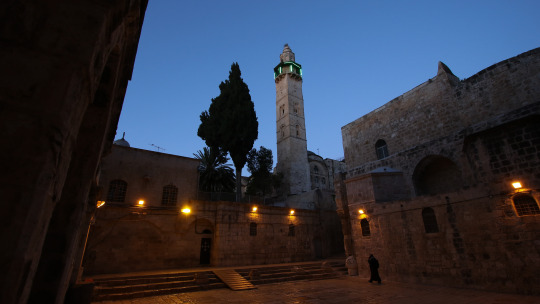
PHOTO 26: It was Saturday; the day of the Jewish Shabbat, a holy day when the highlight of the whole pilgrimage took place: we would have Mass at the Empty Tomb of Christ, in the church of the Holy Sepulchre. Appropriately, we made our way to the church in silence, processing through deserted city, and the church, too, was nearly empty when we arrived. After all, it was shortly after 4 a.m. (!) when we entered the city through Herod’s Gate and walked through the silent Muslim Quarter to the Franciscan monastery.
Moving some 250 people in silence through the uneven streets of an ancient city, before daybreak, is an impressive feat! But this silence and secrecy was entirely fitting. For the Gospels, too, are silent about what happened on the Saturday, the day of the Passover, after Jesus was crucified. St John says the following about the Friday on which Jesus died, the “day of Preparation” but concerning the Sabbath, nothing is reported – it is only alluded to:
“Since it was the day of Preparation, in order to prevent the bodies from remaining on the cross on the sabbath (for that sabbath was a high day), the Jews asked Pilate that their legs might be broken, and that they might be taken away... But one of the soldiers pierced his side with a spear, and at once there came out blood and water... After this Joseph of Arimathe'a, who was a disciple of Jesus, but secretly, for fear of the Jews, asked Pilate that he might take away the body of Jesus, and Pilate gave him leave. So he came and took away his body. Nicodemus also, who had at first come to him by night, came bringing a mixture of myrrh and aloes, about a hundred pounds' weight. They took the body of Jesus, and bound it in linen cloths with the spices, as is the burial custom of the Jews. Now in the place where he was crucified there was a garden, and in the garden a new tomb where no one had ever been laid. So because of the Jewish day of Preparation, as the tomb was close at hand, they laid Jesus there.” (Jn 19:31, 34, 38-42)
From the Franciscan Monastery of the Flagellation, we began our quiet journey on the Via Dolorosa, sleepy but alert, praying the Stations of the Cross as best as we could. Somewhere in the crowd, Jim Caviezel walked with us, as together with him we walked the path of Jesus through the streets of Jerusalem.
At around 5:30 a.m. we prayed the last three stations of the Cross in the courtyard in front of the church of the Holy Sepulchre; in the distance, a cock crowed.
This photo was taken shortly after everyone had entered the church, looking back towards the way we had come; the minaret of the mosque of Omar looms overhead. For many of our group, it was their first time visiting Calvary and the Empty Tomb so I remained outside and I savoured the cool air of the morning; and soaked in the silence of the holy courtyard, traversed only by a cat or a monk; and I observed the colour of the sky change as the light of the new day came. Dawn at the Holy Sepulchre on an Easter Saturday: what a blessed moment!
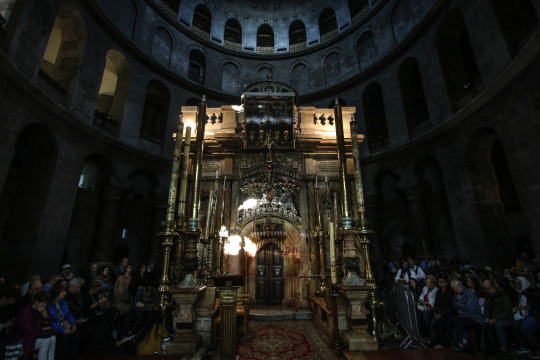
PHOTO 27: We had a good hour and a half before the time allocated to us for Mass: time to explore, time to pray and reflect, time for Confession and spiritual preparation for Holy Mass. Ahead of us, saying Mass inside the Empty Tomb with a small group of pilgrims, was the Bishop of a French diocese, hence the doors are closed. During this time, one of our group took photos of these closed doors and she came and showed me the photos. One of them had the clear figure of a man robed in a white Jewish prayer shawl standing in the doorway, even though none of us had seen the doors even open! Take a look here and see what you think!
"I saw the risen Lord appearing to His Blessed Mother on Mount Calvary. He was transcendently beautiful and glorious, His manner full of earnestness. His garment, which was like a white mantle thrown about His limbs, floated in the breeze behind Him as He walked. It glistened blue and white, like smoke curling in the sunshine.” - Blessed Anne Catherine Emmerich’s vision of the Risen Lord.
The photo above was taken very shortly before we went into the sacristy to prepare for Mass. I had been watching the sunlight of the new day penetrate the darkness of the Holy Sepulchre church. The rays of light enter through the smaller dome of the ‘Catholicon’ (the Greek Orthodox sanctuary in the centre of the building), and then it strikes the little onion dome and cross of the ‘Aedicule’, which is this structure that envelopes and protects the Empty Tomb itself. As the sun ascends in the sky, the rays of light then travel downwards until it reaches the doors of the Aedicule, and penetrate into the Empty Tomb.
An hour after this photo was taken, I was standing inside the Aedicule, concelebrating the Holy Mass with my brother priests, standing around the very spot where the angel of the Resurrection had hailed the holy women that first Easter morning. And then, stooping to go into the Empty Tomb itself, I received the Eucharistic Body and Blood of the Risen Christ that was lying on the Altar, on top of the stone where Jesus had been laid and from which he had risen from the dead, alleluia!
This single moment, this sun-lit morning, all we had experienced so far on the 4th of May 2019, was probably one of the most unforgettable and spiritually intense moments of my whole life.
“Do not be afraid... He is not here; for he has risen, as he said. Come, see the place where he lay. Then go quickly and tell his disciples that he has risen from the dead”. (Mt 28:5-7)
However, in every Mass, we encounter the Risen Lord, and we are then sent forth wherever we may be, as though from this Empty Tomb in Jerusalem, to quickly announce the Good News: Χριστός Ανέστη! Surrexit Dominus vere! Christ is risen, Alleluia, alleluia, alleluia!
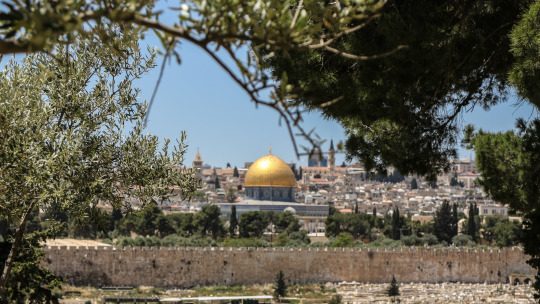
PHOTO 28: The focus of this photo is the olive tree, for we are on the Mount of Olives, looking towards the Holy City with the iconic Dome of the Rock, the Muslim shrine built on the very site where the Temple of Jerusalem once stood until the Romans destroyed it, as Christ prophesied, in 70 AD.
After Mass in the Holy Sepulchre, and after breakfast, we went to the top of the Mount of Olives to take in the view of the city, and then we descended the hill, waving palm branches and singing ‘Hosannas’ as we went; in a few hours we had gone from Easter morning to Palm Sunday! We made our way to the little church of Dominus Flevit where Jesus had beheld the city of Jerusalem, foretold of its destruction, and wept for its people.
Looking towards the city, one takes in its long and complicated and turbulent history; full of human strife and violence as the One the city had once hailed with ‘Hosannas’ was rejected, taken outside, and executed as a criminal. But, as St Paul says: “In him all the fulness of God was pleased to dwell, and through him to reconcile to himself all things, whether on earth or in heaven, making peace by the blood of his cross.” (Col 1:19-20)
In this photo, therefore, I wanted to show the city in its splendour and in its divided history, and also to take in the branches of the trees which the people had cut and waved to hail the coming Messiah. But above all, I wanted to focus on the olive branch, not just because it indicated our location, the Mount of Olives, but because it is a universally recognised emblem of peace.
“For the peace of Jerusalem pray: "Peace be to your homes! May peace reign in your walls, in your palaces, peace!"” – Psalm 122:6-7
Agnus Dei, qui tollis peccata mundi: dona nobis pacem.
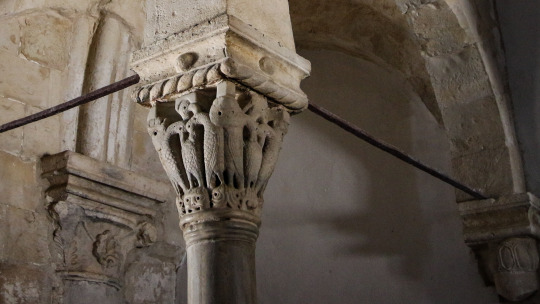
PHOTO 29: Continuing to mark Holy Week in one day, we went to Mount Sion after lunch, to the site of the Upper Room, the cenacle, where Jesus had celebrated the Passover with his disciples, instituting the sacraments of the Holy Eucharist and the Priesthood. In the same room, the Holy Spirit had came upon Our Lady and the disciples at Pentecost so that “out of Sion shall go forth the law, and the word of the LORD from Jerusalem" (Isa 2:3).
So, that Saturday afternoon we stood in a 14th-century structure built on various iterations of a church building that has stood here since the earliest days, although it is now sadly just an archeological space, a museum since beneath it is the tomb of King David, a holy shrine for the Jews and I suppose they did not want a church right above. But in the 5th-century, this holy place was called “Sion, Mother of all the Churches”.
This name is fitting since it is here that the Church was born. As Pope St John Paul II wrote shortly after visiting this place:
The Church, while pointing to Christ in the mystery of his passion, also reveals her own mystery: Ecclesia de Eucharistia. By the gift of the Holy Spirit at Pentecost the Church was born and set out upon the pathways of the world, yet a decisive moment in her taking shape was certainly the institution of the Eucharist in the Upper Room. Her foundation and wellspring is the whole Triduum paschale, but this is as it were gathered up, foreshadowed and “concentrated' for ever in the gift of the Eucharist. – Ecclesia de Eucharistia, 5.
The photo above is focussed on a carved stone capital from c.1335 that is part of the canopy over the platform where, perhaps, the altar would have once stood. This carving is interesting because of its Eucharistic symbolism. Over the past few days we have seen some other early Christian symbols such as the anchor, and the peacock. Here in the cenacle, in the place where Jesus gave us the Eucharist, we have the pelican. To be precise, two pelicans are shown plucking at the breast of the central pelican, and this symbol is known as the ‘Pelican in piety’. It was believed that pelicans would feed their own young with their own flesh and blood, and so this became an image of Christ feeding the Christian people: the Church receives its life from the Eucharist which is the sacrament of Christ’s Body and Blood; Ecclesia de Eucharistia.
So St Thomas Aquinas prayed in his hymn, Adoro Te devote:
Pie Pelicane, Jesu Domine, me immundum munda tuo Sanguine: cujus una stilla salvum facere totum mundum quit ab omni scelere.
Lord Jesus, Good Pelican, wash my filth and cleanse me with Your Blood, one drop of which can free the entire world of all its sins.
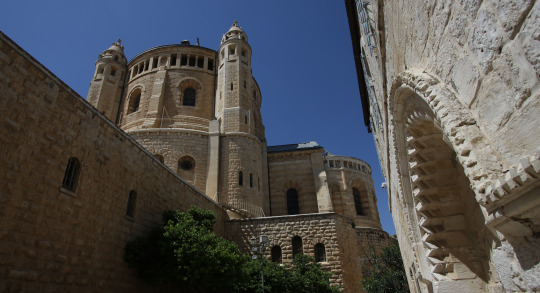
PHOTO 30: Standing at the doorway that leads up to the cenacle, we look back towards the tallest building in the area, built on the summit of Mount Sion. This is the Benedictine Abbey of the Dormition, which commemorates the fact that Our Lady, the “Daughter of Sion” fittingly ended her earthly life somewhere nearby on Mount Sion. Psalm 87, therefore, although it refers to the holy mountain of Sion has also long been regarded as alluding to Our Lady. For the Lord has preferred her to all others and has dwelt within her; like a city whose walls are never breached, so has she remained ever virgin yet is the abode of the great King:
On the holy mountain is his city cherished by the Lord. The Lord prefers the gates of Sion to all Jacob's dwellings. Of you are told glorious things, O city of God! – Psalm 87:1-3
Saturdays, of course, are dedicated to Mary, so within the Dormition Abbey, we had gathered to sing glorious things concerning the Mother of God. As we headed back to the Old City of Jerusalem, passing by the Sion Gate, I stopped to marvel at the many beautiful roses that bloomed here. They were another fitting tribute to Our Lady, and a glorious end to our tour on Lady Day in the Holy Land.
Tomorrow: Reliving Easter Sunday at dawn by the Empty Tomb; Bethesda and Mary’s birthplace; Bar Mitzvah celebrations.
8 notes
·
View notes
Photo

Saint of the Day – St Lawrence of Rome – Martyr and Deacon (ArchDeacon – distributor of alms and “Keeper of the Treasures of the Church”) – (Born at Huesca, Spain – cooked to death on a gridiron on 10 August 258). (Latin: Laurentius, lit. “laurelled”. St Lawrence was one of the seven deacons of the city of Rome, Italy under Pope St Sixtus II who were martyred in the persecution of the Christians that the Roman Emperor Valerian ordered in 258. His remains were buried in the cemetery of Saint Cyriaca on the road to Tivoli, Italy. His tomb was opened by Pelagius to inter the body of Saint Stephen the Martyr and his mummified head removed to the Quirinal Chapel. The gridiron believed to have been his deathbed is in San Lorenzo in Lucina and his garments in Our Lady’s Chapel in the Lateran Palace. Patronages – against fire, against lumbago, of archives, archivists, armories, armourers, brewers, butchers, chefs, cooks, comedians, comediennes, comics, confectioners, cutlers, deacons, glaziers, laundry workers, librarians, libraries, paupers, the poor, restauranteurs, schoolchildren, students, seminarians, stained glass workers, tanners, vine growers, vintners, wine makers, Ceylon, Sri Lanka, 38 cities and dioceses. Attributes – book of Gospels, cross, gridiron, deacon holding a book, deacon holding a gridiron, deacon holding a bag of money, purse of money.
Saint Lawrence was chief of the seven Roman deacons of Pope Sixtus II who had been his mentor in Spain and taken him to Rome and ordained him as Deacon there, after he had been called to the Holy Office. In 258, Emperor Valerian increased his persecutions of the Christians. One day when Pope Sixtus II was in the cemetery of Saint Calistus celebrating Mass accompanied by some members of his clergy, he was arrested. Along with him, the other six Roman deacons were arrested. As the soldiers took the Pontiff to be put to death, Lawrence followed him in anguish crying out: “Where are you going, my father, without your son? Where are you going, Holy Pontiff, without your deacon? Isn’t it the custom to offer the sacrifice with an assistant? Let me prove I am worthy of the choice you made when you entrusted me with the distribution of the Blood of Our Lord.”

The Pope replied to Saint Lawrence: “I am not leaving you, my son. They are lenient on old men, not the youth. A greater combat is reserved for you. You will follow me in three days.” With the Pontiff’s execution, Lawrence was the highest ranking church authority left in Rome.
Saint Lawrence was brought before Cornelius Secularis, prefect of Rome under the Emperor Valerian, who, according to Dom Prosper Guéranger in his Liturgical Year: "aimed at ruining the Christians by prohibiting their assemblies, putting their chief men to death, and confiscating their property." Saint Lawrence asked for a short delay, so he could gather these riches for the prefect and true to the promise of Pope Sixtus, returned three days after the pontiff’s death to hand them over. However, heeding Pope Sixtus II’s final words, Lawrence used his three days to distribute the material wealth of the Church to the poor, before the Roman authorities could lay their hands on it.


When the archdeacon returned, instead of bringing vessels of gold and silver, he brought the poor of the city, saying, “Behold, these choice pearls, these sparkling gems that adorn the temple, these sacred virgins, I mean, and these widows who refuse second marriage…. Behold then, all our riches.” In response to his boldness, Cornelius ordered the scourging and torture of Saint Lawrence upon the rack.

From the Liturgical Year: “…Lawrence was taken down from the rack about midday. In his prison, however, he took no rest but wounded and bleeding as he was, he baptised the converts won to Christ by the sight of his courageous suffering. He confirmed their faith and fired their souls with a martyr’s intrepidity. When the evening hour summoned Rome to its pleasures, the prefect recalled the executioners to their work, for a few hours’ rest had sufficiently restored their energy to enable them to satisfy his cruelty.”
Surrounded by this ill-favored company, the prefect thus addressed the valiant deacon: ‘Sacrifice to the gods, or else the whole night long shall be witness of your torments.’ ‘My night has no darkness,’answered Laurence, ‘and all things are full of light to me.’ They struck him on the mouth with stone, but he smiled and said, ‘I give Thee thanks, O Christ.’
Then an iron bed or gridiron with three bars was brought in and the saint was stripped of his garments and extended upon it while burning coals were placed beneath it. As they were holding him down with iron fork, Lawrence said ‘I offer myself as a sacrifice to God for an odour of sweetness.’ The executioners continually stirred up the fire and brought fresh coals, while they still held him down with their forks. Then the saint said: ‘Learn, unhappy man, how great is the power of my God; for your burning coals give me refreshment but they will be your eternal punishment. I call Thee, O Lord, to witness: when I was accused, I did not deny Thee; when I was questioned, I confessed Thee, O Christ; on the red-hot coals I gave Thee thanks.’ And with his countenance radiant with heavenly beauty, he continued: ‘Yea, I give Thee thanks, O Lord Jesus Christ, for that Thou hast deigned to strengthen me.’ He then raised his eyes to his judge and said: ‘See, this side is well roasted; turn me on the other and eat.’ Then, continuing his canticle of praise to God [he said]: ‘I give Thee thanks, O Lord, that I have merited to enter into Thy dwelling place.’
As he was on the point of death, he remembered the Church. The thought of the eternal Rome gave him fresh strength and he breathed forth this ecstatic prayer: ‘O Christ, only God, O Splendour, O Power of the Father, O Maker of heaven and earth and builder of this city’s walls! Thou has placed Rome’s scepter high over all; Thou hast willed to subject the world to it, in order to unite under one law the nations which differ in manners, customs, language, genius, and sacrifice. Behold the whole human race has submitted to its empire and all discord and dissensions disappear in its unity. Remember thy purpose: Thou didst will to bind the immense universe together into one Christian Kingdom. O Christ, for the sake of Thy Romans, make this city Christian; for to it Thou gavest the charge of leading all the rest to sacred unity. All its members in every place are united – a very type of Thy Kingdom; the conquered universe has bowed before it. Oh! may its royal head bowed in turn! Send Thy Gabriel and bid him heal the blindness of the sons of Iulus, that they may know the true God. I see a prince who is to come – an Emperor who is a servant of God. He will not suffer Rome to remain a slave; he will close the temples and fasten them with bolts forever.’




Thus he prayed and with these last words, he breathed forth his soul. Some noble Romans who had been conquered to Christ by the martyr’s admirable boldness, removed his body: the love of the most high God had suddenly filled their hearts and dispelled their former errors. From that day, the worship of the infamous gods grew cold; few people went now to the temples but hastened to the altars of Christ. Thus Lawrence, going unarmed to the battle, had wounded the enemy with his own sword.”
The burned body of Saint Lawrence was carried away by converted Roman Senators who buried him in a grotto in the Verano field, near Tivoli. On this day, the reliquary containing his burnt head is displayed in the Vatican for veneration. His feast spread throughout Italy and northern Africa after his martyrdom—and even Saint Augustine of Hippo wrote a beautiful sermon on St Lawrence’s life, connecting his “treasures of the Church” to martyrdom and the Holy Eucharist. Emperor Constantine built a beautiful basilica in Lawrence’s honour. Saint Lawrence is especially honoured in the city of Rome, where he is one of the city’s patrons. There are several churches in Rome dedicated to him, including San Lorenzo in Panisperna, traditionally identified as the place of his execution. The gridiron on which he was grilled is venerated there today.



Since the Perseid Meteor Shower typically occurs every year in mid-August, on or near Saint Lawrence’s feast day, some refer to the shower as the “Burning Tears of Saint Lawrence.” Saint Lawrence, for his care and love of the poor, is considered their patron. For having saved the treasures of the Church—including its documents, he is recognized as the patron saint of librarians. For his courage in being grilled to death, he is also the patron saint of cooks and kitchen workers.
St Lawrence pray for us all!




(via AnaStpaul – Breathing Catholic)
56 notes
·
View notes
Text
Why I'm still Catholic: My father's death
Great News has been shared on https://apostleshop.com/why-im-still-catholic-my-fathers-death/
Why I'm still Catholic: My father's death
Copyright 2019 Roxane Salonen. All rights reserved.
There was perhaps no time I felt more grateful to still be Catholic than at my father’s death.
Perhaps the easiest explanation is that he grew up in a faithful Catholic home, the youngest son of nine children, with a mother devoted to God and her family, in that order. Though I never got to meet Grandma Mary, or “Daught” as they called her, I have heard the stories of her deep faith, and know that she’s been praying for me — and her baby boy — all these years. Even during the 35 years he left the faith, a time that likely left her, for a while, weeping.
And yet, her prayers were powerful, and he did return, fully. My father died a man still in need of physical healing, but I believe spiritually he was the fittest of his life. Though I pray for him often, I have little doubt he is with God, the communion of saints and his loved ones that have gone on before us — including his little grandson, our son who died in miscarriage, Gabriel. The moment Dad died, I said, “You get to see your Mama now.” And I believe the tear that came from him was his response. “Yes.” Yes to God. Yes to love. Yes to the reunion spreading before him.
I realized then that though I, too, had wandered away for some time, not fully gone but not completely convinced I was in the right place, I, too, had found my way back. We’d both returned home to the blessed place where we’d begun our Christian journey, in Jesus’ Church. This brought an immense amount of comfort, aided by all the wonderful Catholic devotions and practices that were ours to utilize and appreciate.
Namely, the Divine Mercy Chaplet, a devotion inspired by Jesus through St. Faustina Kowalska, a humble Polish nun who reminded us of Jesus’ great mercy for us. The prayer, recited on rosary beads, is especially efficacious at death, or in the presence of someone gravely ill. My memory of my mother and I singing this prayer at my father’s deathbed will always be a treasured remembrance and source of comfort.
In tending to my dying father, I was tending to the suffering Christ -@peacegardenmama Click To Tweet
I had the great privilege and grace to be with Dad not only in his final days, but his final hours, and the experience can only be described, then and now, as holy. In tending to my dying father, I was tending to the suffering Christ, and so Christ was everywhere in that room. I felt it palpably, and deeply. It was a sacred time, even if, yes, extremely sad. My tears were dried by Jesus’ mother, whom I know was near, too.
Last night, on the eve of the anniversary of my daddy’s death six years ago, in the crisp winter night, I stole away to the Our Lady of Guadalupe Adoration Chapel here in Fargo, one of my favorite places to be — a place where the presence of God floods the air like sweet incense — and spent time with Jesus in the Eucharistic host. There, I rested in the memory of that day, when I held my father’s hand as he took his very last breath here, right before he left to fulfill his most important earthly mission, to be with God.
Even six years later, I am overcome with gratitude for the way God arranged things; how I was able to make a temporary home in his hospital room and just love him, to help gently usher his soul into the eternal. His death was early, at 77, and not initially expected, but by the time I reached him in those final days, we saw that his body was shutting down. And so there was nothing left to do, nothing at all, but to love.
In the Adoration chapel last night, I wrote the following reflection about that last hour with Dad:
“Dear Lord … 6 years ago … I was camped out at the deathbed of my father, almost like now, here at Adoration. And in a way, I was adoring you — in the suffering Christ, in the tomb of my father. Unable to speak, he was yours already. And yet you, in your great love for us, gave us that gift of time. Of love. Pure love … There was nothing really but love, going in, coming out. It was the first time I’d experienced love like that, in such a primal way. It was a holy time…Our dad did not leave this world a man of influence. His brilliant pen had long gone still. He had nothing to offer, Lord. … He was in a sense a beggar. But he was rich in you! He had you back. He had broken through the chains and could see you there, loving him. And because of that – because he believed once more that he was loved purely — he could love us that way too, at least in his heart. Physical limitations made perfect love impossible, but we knew, because you relayed the message, and it was known to us. Love, pure and deep. Thank you, Lord. Please welcome my daddy into your eternal bliss. Love, Rock.”
Being able to share my faith with Dad in those final moments, to be comforted by the sheer beauty of the Catholic Mass that followed at the Holy Spirit Cathedral in Bismarck, N.D. — even to have the courage and grace to sing at it — will always be a gift. Death is not happy. To lose someone we love is a breach of something beautiful. And yet when we die in faith, or lose those we love in the state of grace, it can be sublime.
Because of my dad’s death, how it went down, and how deeply I was able to access heaven itself through being right there with this man who had already been resurrected in faith in life, and to share a glimpse of the glory with him as offered in particular through our beautiful Catholic faith, I find all this one more shining reason why, despite all the scandal, tumult and everything else affecting our faith in this time in history, I am still Catholic, thanks be to God.
Additional “Why are you still Catholic?” posts, a series I began in November on my blog, Peace Garden Passage, include: Confession, relics, Mary, The Eucharist, Christmas, and the saints.
Q4U: When has God revealed heaven to you?
Copyright 2019 Roxane Salonen
Source link
0 notes